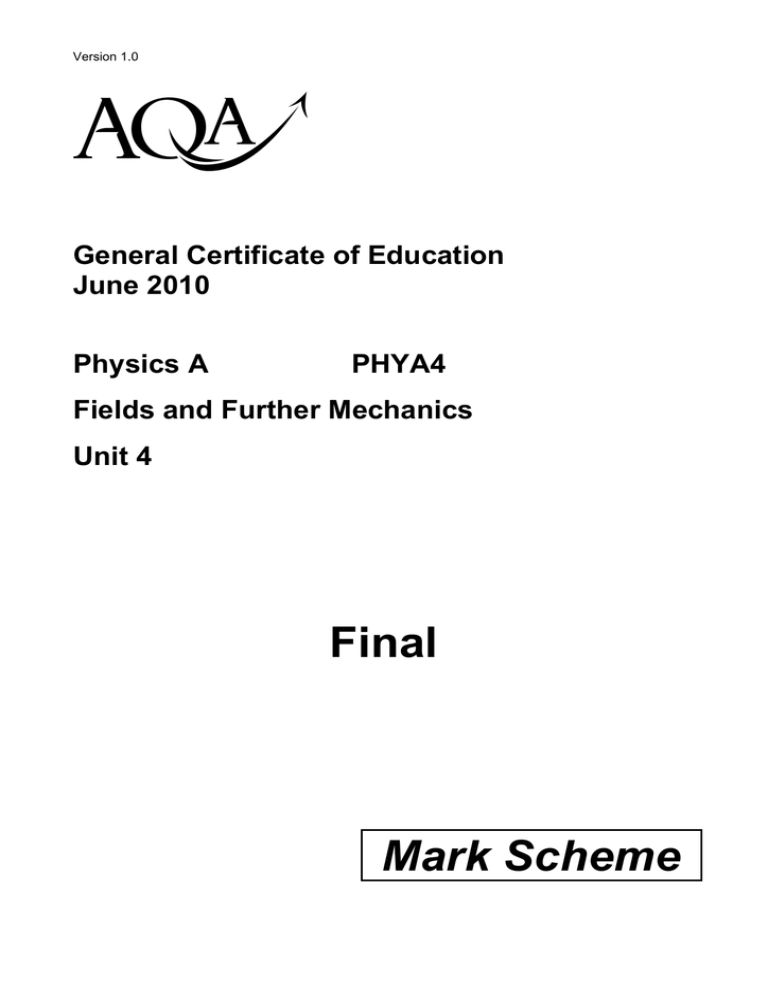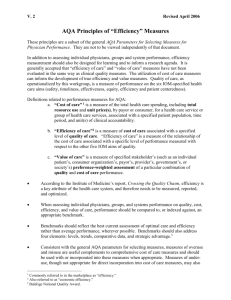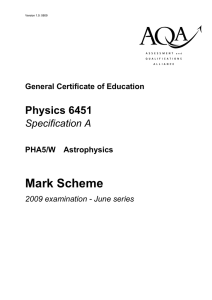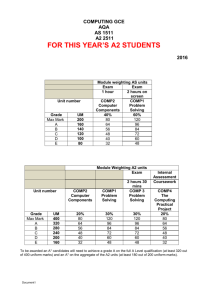
Version 1.0
klm
General Certificate of Education
June 2010
Physics A
PHYA4
Fields and Further Mechanics
Unit 4
Final
Mark Scheme
Mark schemes are prepared by the Principal Examiner and considered, together with the relevant
questions, by a panel of subject teachers. This mark scheme includes any amendments made at
the standardisation meeting attended by all examiners and is the scheme which was used by them
in this examination. The standardisation meeting ensures that the mark scheme covers the
candidates’ responses to questions and that every examiner understands and applies it in the
same correct way. As preparation for the standardisation meeting each examiner analyses a
number of candidates’ scripts: alternative answers not already covered by the mark scheme are
discussed at the meeting and legislated for. If, after this meeting, examiners encounter unusual
answers which have not been discussed at the meeting they are required to refer these to the
Principal Examiner.
It must be stressed that a mark scheme is a working document, in many cases further developed
and expanded on the basis of candidates’ reactions to a particular paper. Assumptions about
future mark schemes on the basis of one year’s document should be avoided; whilst the guiding
principles of assessment remain constant, details will change, depending on the content of a
particular examination paper.
Further copies of this Mark Scheme are available to download from the AQA Website: www.aqa.org.uk
Copyright © 2010 AQA and its licensors. All rights reserved.
COPYRIGHT
AQA retains the copyright on all its publications. However, registered centres for AQA are permitted to copy material
from this booklet for their own internal use, with the following important exception: AQA cannot give permission to
centres to photocopy any material that is acknowledged to a third party even for internal use within the centre.
Set and published by the Assessment and Qualifications Alliance.
The Assessment and Qualifications Alliance (AQA) is a company limited by guarantee registered in England and Wales (company number 3644723) and a registered charity (registered charity number 1073334).
Registered address: AQA, Devas Street, Manchester M15 6EX
Physics A PHYA4 - AQA GCE Mark Scheme 2010 June series
Instructions to Examiners
1
Give due credit for alternative treatments which are correct. Give marks for what is correct in
accordance with the mark scheme; do not deduct marks because the attempt falls short of some
ideal answer. Where marks are to be deducted for particular errors, specific instructions are
given in the marking scheme.
2
Do not deduct marks for poor written communication. Refer the scripts to the Awards meeting if
poor presentation forbids a proper assessment. In each paper, candidates are assessed on their
quality of written communication (QWC) in designated questions (or part-questions) that require
explanations or descriptions. The criteria for the award of marks on each such question are set
out in the mark scheme in three bands in the following format. The descriptor for each band sets
out the expected level of the quality of written communication of physics for each band. Such
quality covers the scope (eg relevance, correctness), sequence and presentation of the answer.
Amplification of the level of physics expected in a good answer is set out in the last row of the
table. To arrive at the mark for a candidate, their work should first be assessed holistically (ie in
terms of scope, sequence and presentation) to determine which band is appropriate then in terms
of the degree to which the candidate’s work meets the expected level for the band.
QWC
descriptor
mark range
Good - Excellent
see specific mark scheme
5-6
Modest - Adequate
see specific mark scheme
3-4
Poor - Limited
see specific mark scheme
1-2
The description and/or explanation expected in a good answer should include a
coherent account of the following points:
see specific mark scheme
Answers given as bullet points should be considered in the above terms. Such answers without
an ‘overview’ paragraph in the answer would be unlikely to score in the top band.
3
An arithmetical error in an answer will cause the candidate to lose one mark and should be
annotated AE if possible. The candidate’s incorrect value should be carried through all
subsequent calculations for the question and, if there are no subsequent errors, the candidate
can score all remaining marks.
4
The use of significant figures is tested once on each paper in a designated question or partquestion. The numerical answer on the designated question should be given to the same
number of significant figures as there are in the data given in the question or to one more than
this number. All other numerical answers should not be considered in terms of significant figures.
5
Numerical answers presented in non-standard form are undesirable but should not be penalised.
Arithmetical errors by candidates resulting from use of non-standard form in a candidate’s
working should be penalised as in point 3 above. Incorrect numerical prefixes and the use of a
given diameter in a geometrical formula as the radius should be treated as arithmetical errors.
6
Knowledge of units is tested on designated questions or parts of questions in each a paper. On
each such question or part-question, unless otherwise stated in the mark scheme, the mark
scheme will show a mark to be awarded for the numerical value of the answer and a further mark
for the correct unit. No penalties are imposed for incorrect or omitted units at intermediate stages
in a calculation or at the final stage of a non-designated ‘unit’ question.
7
All other procedures including recording of marks and dealing with missing parts of answers will
be clarified in the standardising procedures.
3
Physics A PHYA4 - AQA GCE Mark Scheme 2010 June series
GCE Physics, Specification A, PHYA4, Fields and Further Mechanics
Section A
This component is an objective test for which the following list indicates the correct answers used in
marking the candidates’ responses.
Keys to Objective Test Questions
1
2
3
4
5
6
7
8
9
10
11
12
13
B
C
D
D
D
C
A
B
A
A
B
D
A
14
15
16
17
18
19
20
21
22
23
24
25
A
B
D
A
C
A
C
B
B
D
C
C
Section B
Question 1
(a)
force of attraction between two point masses (or particles) !
proportional to product of masses !
inversely proportional to square of distance between them !
[alternatively
max 2
quoting an equation, F =
!"# "$
%$
with all terms defined !
reference to point masses (or particles) or r is distance between centres !
F identified as an attractive force !]
(b)
(i)
mass of larger sphere ML (= πr3ρ) = π × (0.100)3 × 11.3 × 103 !
= 47(.3) (kg) !
[alternatively
use of M ∝ r3 gives
2
"&
'.()
* +
,'' 0
-.
/ ! (= 64)
and ML = 64 × 0.74 = 47(.4) (kg) !]
(b)
(ii)
gravitational force F +*
!"&: "1
2$
/*
3.3( 4 ,'5## 4 )(.0 4 '.()
'.,-.$
!
2
= 1.5 × 10−7 (N) !
(c)
for the spheres, mass ∝ volume (or ∝ r3, or M = πr3ρ) !
mass of either sphere would be 8 × greater (378 kg, 5.91 kg) !
this would make the force 64 × greater !
max 4
but separation would be doubled causing force to be 4 × smaller !
net effect would be to make the force (64/4) = 16 × greater ! (ie 2.38 × 10−6 N)
Total
4
10
Physics A PHYA4 - AQA GCE Mark Scheme 2010 June series
Question 2
(a)
(i)
(vertically) downwards [or top to bottom, or down the page] !
1
(a)
(ii)
force on sphere F (= kx) = 0.24 × 18 × 10−3 ! (= 4.32 × 10−3 N)
1
(a)
(iii)
use of F = EQ gives E =
use of E =
8
9
).0- 4 ,'56
), 4 ,'57
gives separation d =
! (= 1.05 × 105 V m−1)
..' 4 ,'6
,.'. 4 ,':
3
!
= 4.8 × 10−2 (m) ! (4.76 × 10−2)
(b)
(i)
electric field becomes zero (or ceases to exist) !
flow of charge (or electrons) from one plate to the other [or plates
discharge] !
max 2
(until) pd across plates becomes zero [or no pd across plates, or plates at
same potential] !
(b)
(ii)
net downward force on sphere (when E becomes zero) [or gravitational
force acts on sphere, or force is weight] !
this force extends spring !
force (or acceleration) is proportional to (change in) extension of spring !
acceleration is in opposite direction to displacement (or towards
equilibrium) !
max 3
for shm, acceleration ∝ (−) displacement [or for shm, force ∝ (−)
displacement] !
Total
5
10
Physics A PHYA4 - AQA GCE Mark Scheme 2010 June series
Question 3
(a)
The candidate’s writing should be legible and the spelling,
punctuation and grammar should be sufficiently accurate for the
meaning to be clear.
The candidate’s answer will be assessed holistically. The answer will be
assigned to one of three levels according to the following criteria.
High Level (Good to excellent): 5 or 6 marks
The information conveyed by the answer is clearly organised, logical and
coherent, using appropriate specialist vocabulary correctly. The form and
style of writing is appropriate to answer the question.
The candidate states that momentum is conserved, supported by reasoning
to explain why the conditions required for momentum conservation are
satisfied in this case.
The candidate also gives a statement that total energy is conserved, giving
detailed consideration of the energy conversions which take place,
described in the correct sequence, when there is an explosion on a body
that is already moving.
Intermediate Level (Modest to adequate): 3 or 4 marks
The information conveyed by the answer may be less well organised and
not fully coherent. There is less use of specialist vocabulary, or specialist
vocabulary may be used incorrectly. The form and style of writing is less
appropriate.
The candidate states that momentum is conserved, but the reasoning is
much more limited.
and/or
There is a statement that (total) energy is conserved, with basic
understanding that some energy is released by the explosion.
Low Level (Poor to limited): 1 or 2 marks
The information conveyed by the answer is poorly organised and may not
be relevant or coherent. There is little correct use of specialist vocabulary.
The form and style of writing may be only partly appropriate.
The candidate indicates that either momentum or energy is conserved, or
that both are conserved. There are very limited attempts to explain either of
them.
6
max 6
Physics A PHYA4 - AQA GCE Mark Scheme 2010 June series
The explanation expected in a competent answer should include a
coherent selection of the following points concerning the physical
principles involved and their consequences in this case.
Momentum
•
momentum is conserved because there are no external forces
acting on the overall system (probe plus capsule) – or because it’s
free space
•
they are moving in free space and are therefore so far from large
masses that gravitational forces are negligible
•
during the explosion, there are equal and opposite forces acting
between the probe and the capsule
•
these are internal forces that act within the overall system
•
because momentum has to be conserved, and it is a vector, the
capsule must move along the original line of movement after the
explosion
Energy
(b)
(i)
•
total energy is always conserved in any physical process because
energy can be neither created nor destroyed
•
however, energy may be converted from one form to another
•
the probe is already moving and has kinetic energy
•
in the explosion, some chemical energy is converted into kinetic
energy (and some energy is lost in heating the surroundings)
•
the system of probe and capsule has more kinetic energy than the
probe had originally, because some kinetic energy is released by
the explosion
conservation of momentum gives (500 × 160) = 150 v + (350 × 240) !
from which v = (−)26(.7) (m s−1) !
3
direction: opposite horizontal direction to larger fragment [or to the left, or
backwards] !
(b)
(ii)
initial Ek = ½ × 500 × 1602 ! (= 6.40 × 106 J)
final Ek = (½ × 350 × 2402) + (½ × 150 × 26.72) ! (= 1.01 × 107 J)
4
energy released by explosion = final Ek − initial Ek !
= 3.7 × 106 (J) !
Total
7
13
Physics A PHYA4 - AQA GCE Mark Scheme 2010 June series
Question 4
(a)
magnetic field direction: −z !
(b)
direction changes meaning that velocity is not constant !
1
acceleration involves change in velocity
(or acceleration is rate of change of velocity) !
2
[alternatively
magnetic force on electron acts perpendicular to its velocity !
∴force changes direction of movement causing acceleration !]
(c)
(i)
BQv =
=
(c)
(ii)
;< $
%
! gives v +*
=>%
;
/
2
'.)0 4 ,'56 4 ,.3' 4 ,'5#7 4 () 4 ,'56
6
! (= 5.59 × 10 m s )
?.,, 4 ,'56#
angular speed ω +*
<
%
/*
−1
...? 4 ,'@
() 4 ,'56
= 7.5(5) × 107 !
2
unit: rad s−1 ! (accept s−1)
(c)
(iii)
frequency of electron’s orbit f +*
A
-B
/=
(... 4 ,'C
-B
! (= 1.20 × 107 s−1)
number of transits min−1 = 1.20 × 107 × 60 = 7.2 × 108 !
[alternatively
orbital period +*
-B%
<
/*
-B 4 () 4 ,'56
...? 4 ,'@
[or +*
-B
A
/*
-B
2
5C ] !
(... 4 ,'
−8
(= 8.32 × 10 s)
number of transits min−1 =
3'
D.0- 4 ,'5E
= 7.2 × 108 !]
Total
8
9
Physics A PHYA4 - AQA GCE Mark Scheme 2010 June series
Question 5
flux linkage (= Nφ = BAN cos θ )
(a)
= 2.8 × 10−2 × 1.9 × 10−3 × 50 × cos 35° !
3
= 2.2 × 10−3 (Wb turns) !
answer must be to 2 sf only !
(b)
(i)
reasonable sine curve drawn on axes, showing just one cycle, starting at
emf = 0 !
1
(b)
(ii)
the flux linkage in these positions is zero !
1
(b)
(iii)
induced emf ∝ (or =) rate of change of flux (linkage) !
flux (linkage) through the coil changes as it is rotated !
from maximum at θ = 0, 180° to zero at 90° and 270° !
rate of change is greatest when plane of coil is parallel to B [or reference to
ε = BANω sin ωt, orε = BANω sin θ] !
max 3
because coil then cuts flux lines perpendicularly [or ε = BANω sin ωt shows
ε is greatest when ωt = 90° or 270°] !
Total
9
8







